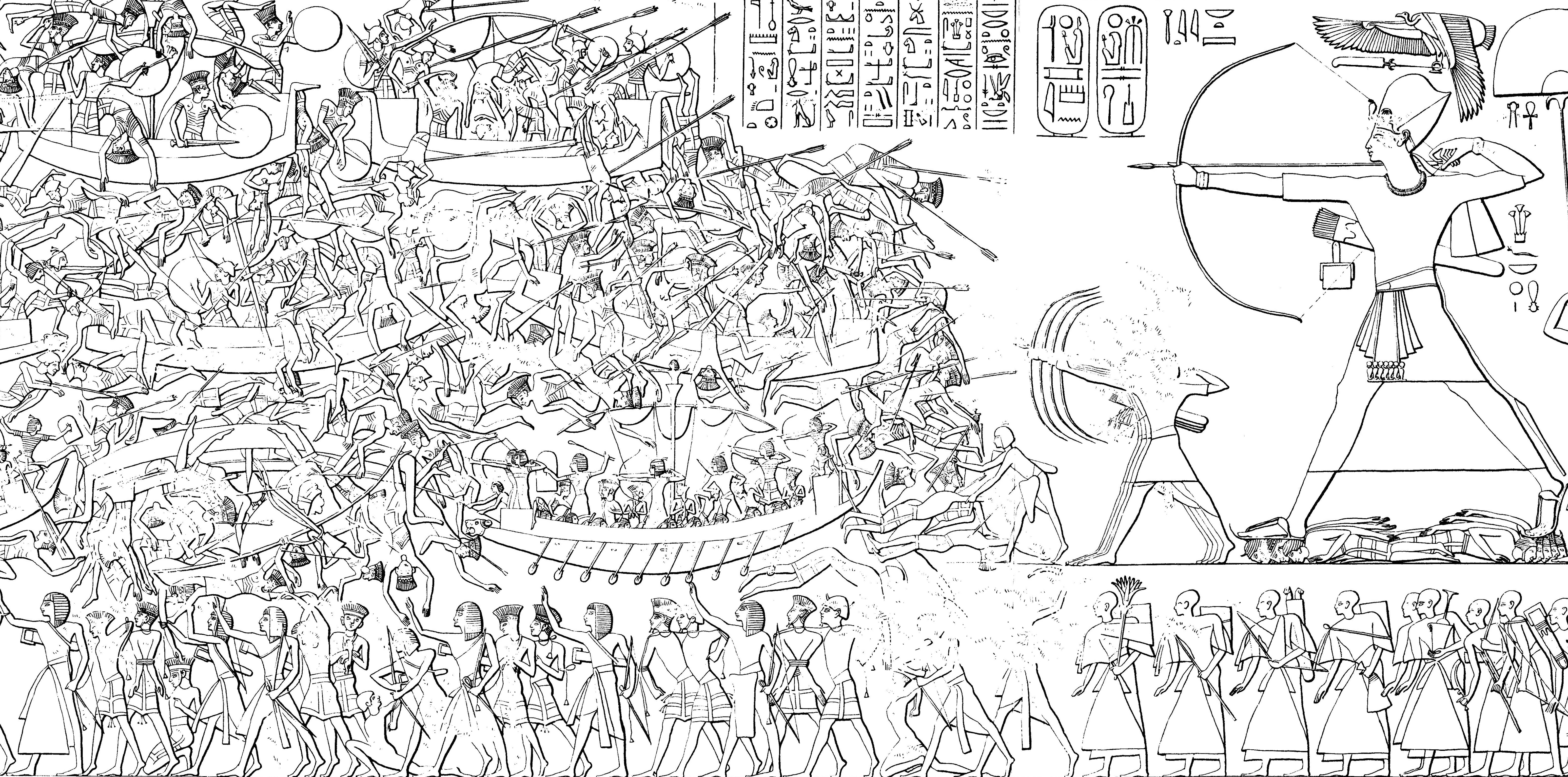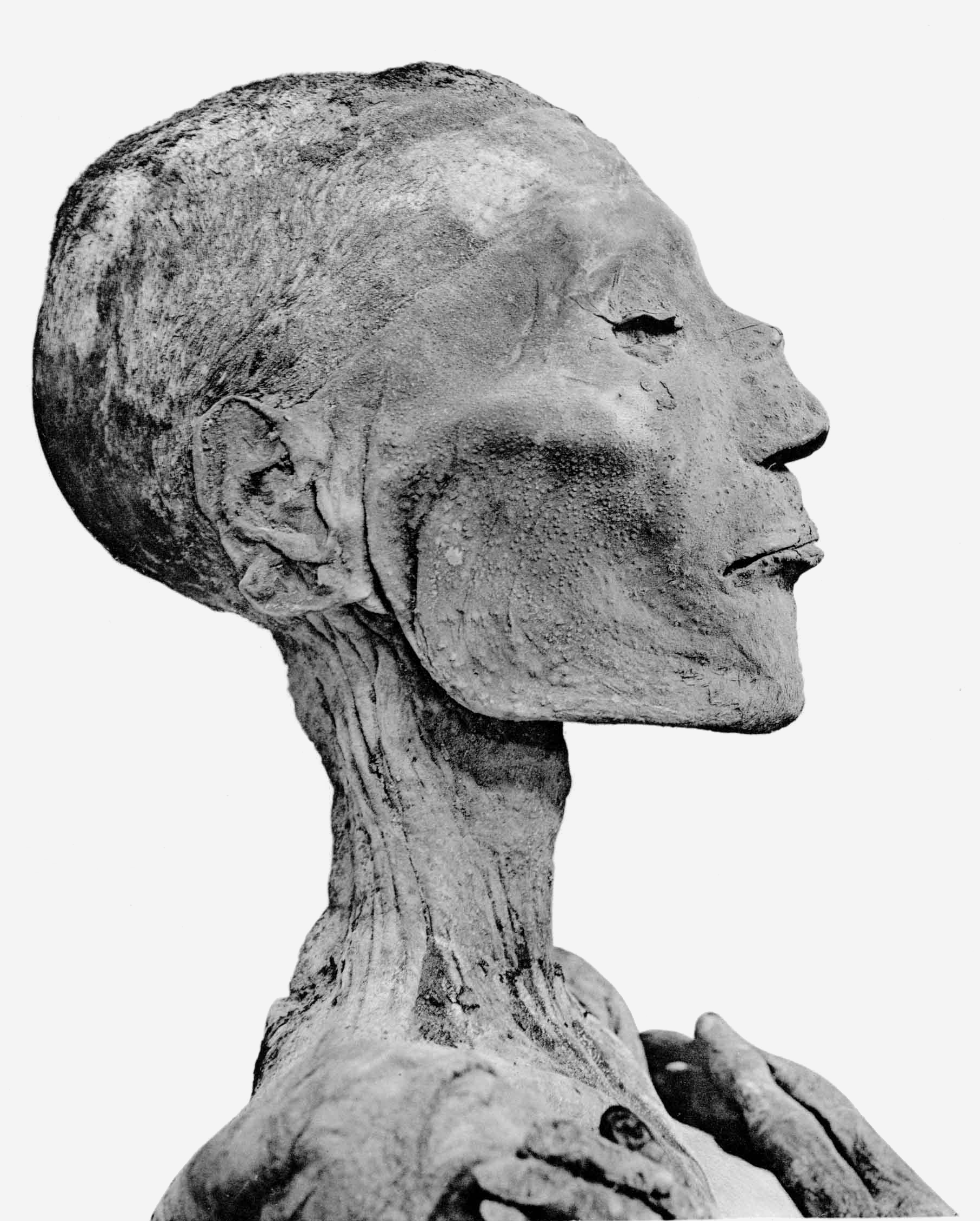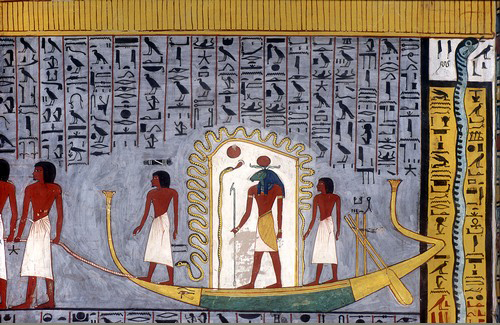|
KV9
Tomb KV9 in Egypt's Valley of the Kings was originally constructed by Pharaoh Ramesses V. He was interred here, but his uncle, Ramesses VI, later reused the tomb as his own. The architectural layout is typical of the 20th Dynasty – the Ramesside period – and is much simpler than that of Ramesses III's tomb ( KV11). The workmen accidentally broke into KV12 as they dug one of the corridors. In 2020, the Egyptian Tourism Authority released a full 3D model of the tomb with detailed photography, available online. Decoration The tomb has some of the most diverse decoration in the Valley of the Kings. In fact Ramesses VI, in a break with tradition, used the decoration program of the Osireion at Abydos as the template for his tomb. Its layout consists of a long corridor, divided by pilasters into several sections, leading to a pillared hall, from which a second long corridor descends to the burial chamber. The digging of the burial chamber was not fully completed; its back wal ... [...More Info...] [...Related Items...] OR: [Wikipedia] [Google] [Baidu] |
Ramesses VI
Ramesses VI Nebmaatre-Meryamun (sometimes written Ramses or Rameses, also known under his princely name of Amenherkhepshef C) was the fifth ruler of the Twentieth Dynasty of Egypt. He reigned for about eight years in the mid-to-late 12th century BC and was a son of Ramesses III and queen Iset Ta-Hemdjert. As a prince, he was known as Ramesses Amunherkhepeshef and held the titles of royal scribe and cavalry general. He was succeeded by his son, Ramesses VII, Ramesses VII Itamun, whom he had fathered with queen Nubkhesbed. After the death of the ruling pharaoh, Ramesses V, who was the son of Ramesses VI's older brother, Ramesses IV, Ramesses VI ascended the throne. In the first two years after his Coronation of the pharaoh, coronation, Ramesses VI stopped frequent raids by Libyan or Egyptian marauders in Upper Egypt and buried his predecessor in what is now an unknown tomb of the Theban necropolis. Ramesses VI usurped KV9, a tomb in the Valley of the Kings planned by and for Rames ... [...More Info...] [...Related Items...] OR: [Wikipedia] [Google] [Baidu] |
KV12
Located in the Valley of the Kings, Tomb KV12 is an unusual tomb, used originally in the Eighteenth Dynasty of Ancient Egypt Ancient Egypt () was a cradle of civilization concentrated along the lower reaches of the Nile River in Northeast Africa. It emerged from prehistoric Egypt around 3150BC (according to conventional Egyptian chronology), when Upper and Lower E ..., and then again in the Nineteenth and Twentieth Dynasties. It was probably used for multiple burials of royal family members, similarly to KV5. The builders of KV9 broke unintentionally into KV12 whilst excavating that tomb. James Burton, who visited the tomb in the 1820s or 1830s, recorded the presence of mummified remains. Reeves & Wilkinson p. 109 References * Pinch-Brock, L., Collisions, Abandonments, Alterations, Tomb Commencements/Pits, and Other Features in the Valley of the Kings, in The Oxford Handbook of the Valley of the Kings, 2014, Oxford University Press. * Reeves, N. & Wilkinson, R ... [...More Info...] [...Related Items...] OR: [Wikipedia] [Google] [Baidu] |
Twentieth Dynasty Of Egypt
The Twentieth Dynasty of Egypt (notated Dynasty XX, alternatively 20th Dynasty or Dynasty 20) is the third and last dynasty of the Ancient Egyptian New Kingdom period, lasting from 1189 BC to 1077 BC. The 19th and 20th Dynasties together constitute an era known as the Ramesside period owing to the predominance of rulers with the given name "Ramesses". This dynasty is generally considered to mark the beginning of the decline of Ancient Egypt at the transition from the Late Bronze to Iron Age. During the period of the Twentieth Dynasty, Ancient Egypt faced the crisis of invasions by Sea Peoples. The dynasty successfully defended Egypt, while sustaining heavy damage. History After the death of the last pharaoh of the 19th Dynasty, Queen Twosret, Egypt entered into a period of civil war. Because of lost historical records, the cause of the civil war is unknown. The war was ended with the accession to the throne by Setnakhte, who founded the 20th Dynasty of Egypt. From the reign ... [...More Info...] [...Related Items...] OR: [Wikipedia] [Google] [Baidu] |
Ramesses V
Usermaatre Sekheperenre Ramesses V (also written Ramses and Rameses) was the fourth pharaoh of the Twentieth Dynasty of Egypt and was the son of Ramesses IV and Duatentopet. His mummy is now on display at the National Museum of Egyptian Civilization in Cairo. Reign Ramesses V's reign was characterized by the continued growth of the power of the priesthood of Amun, which controlled much of the temple land in the country and the state finances, at the expense of the ruling pharaohs. The Turin 1887 papyrus records a financial scandal during Ramesses' reign that involved the priests of Elephantine. Year 1 A period of domestic instability also afflicted his reign, as evidenced by the fact that, according to the Turin Papyrus Cat. 2044, the workmen of Deir el-Medina periodically stopped work on Ramesses V's KV9 tomb in this king's first regnal year, out of fear of "''the enemy''", presumably Libyan raiding parties, who had reached the town of Per-Nebyt and "''burnt its people''." ... [...More Info...] [...Related Items...] OR: [Wikipedia] [Google] [Baidu] |
List Of Burials In The Valley Of The Kings
The following is a list of burials in the Valley of the Kings, in Thebes (modern Luxor, Egypt) and nearby areas. The numbering system was established by John Gardner Wilkinson in 1821. Wilkinson numbered the 21 tombs known to him (some of which had been open since antiquity) according to their location, starting at the entrance to the valley and then moving south and west. Tombs that have been discovered since then have been allocated a sequential KV number (those in the Western Valley are known by the WV equivalent) in the order of their discovery. Since the mid 20th century, Egyptologists have used the acronym An acronym is a type of abbreviation consisting of a phrase whose only pronounced elements are the initial letters or initial sounds of words inside that phrase. Acronyms are often spelled with the initial Letter (alphabet), letter of each wor ... "KV" (standing for Kings' Valley) to designate tombs located in the Valley of the Kings. Additionally, the acronym "WV ... [...More Info...] [...Related Items...] OR: [Wikipedia] [Google] [Baidu] |
Valley Of The Kings
The Valley of the Kings, also known as the Valley of the Gates of the Kings, is an area in Egypt where, for a period of nearly 500 years from the Eighteenth Dynasty to the Twentieth Dynasty, rock-cut tombs were excavated for pharaohs and powerful nobles under the New Kingdom of ancient Egypt. It is a wadi sitting on the west bank of the Nile, opposite Thebes (modern-day Luxor) and within the heart of the Theban Necropolis.Siliotti (1997), p. 13 There are two main sections: the East Valley, where the majority of the royal tombs are situated; and the West Valley, otherwise known as the Valley of the Monkeys. With the 2005 discovery of a new chamber and the 2008 discovery of two further tomb entrances, the Valley of the Kings is known to contain 65 tombs and chambers, ranging in size from the simple pit that is KV54 to the complex tomb that is KV5, which alone has over 120 chambers for the sons of Ramesses II. It was the principal burial place for the New Kingdom's major roya ... [...More Info...] [...Related Items...] OR: [Wikipedia] [Google] [Baidu] |
Book Of Gates
The Book of Gates is an ancient Egyptian funerary text dating from the New Kingdom. The ''Book of Gates'' is long and detailed, consisting of one hundred scenes. It narrates the passage of a newly deceased soul into the next world journeying with the sun god, Ra, through the underworld during the hours of the night towards his resurrection. The soul is required to pass through a series of 'gates' at each hour of the journey. Each gate is guarded by a different serpent deity that is associated with a different goddess. It is important that the deceased knows the names of each guardian. Depictions of the judgment of the dead are shown in the last three hours. The text implies that some people will pass through unharmed, but others will suffer torment in a lake of fire. At the end of Ra's journey through the underworld, he emerges anew to take his place back in the sky. History The text was not named by the Egyptians. It was named by French Egyptologist Gaston Maspero who ca ... [...More Info...] [...Related Items...] OR: [Wikipedia] [Google] [Baidu] |
Meretseger
Meretseger (also known as Mersegrit' or Mertseger) was a Theban cobra-goddess in ancient Egyptian religion, in charge with guarding and protecting the vast Theban Necropolis — on the west bank of the Nile, in front of Thebes — and especially the heavily guarded Valley of the Kings.Hart 1986, pp. 119–120.Wilkinson 2003, p. 224. Her cult was typical of the New Kingdom of Egypt (1550–1070 BC).Hart 1986, p. 120. Role and characteristics Meretseger's name means "She Who Loves Silence",The British Museum Book of Ancient Egypt (2007), London: The British Museum Press. . p. 104. in reference to the silence of the desert cemetery area she kept or, according to another interpretation, "Beloved of Him Who Makes Silence (Osiris)".Ions 1973, pp. 116, 118. Meretseger was the patron of the artisans and workers of the village of Deir el-Medina, who built and decorated the great royal and noble tombs. Desecrations of rich royal burials were already in progress from the Old Kingdom o ... [...More Info...] [...Related Items...] OR: [Wikipedia] [Google] [Baidu] |
Book Of The Earth
The Book of the Earth () is an Ancient Egyptian funerary text that has been called many names such as The Creation of the Sun Disk and the Book of Aker. The Book primarily appears on the tombs of Merneptah, Twosret, Ramesses III, Ramesses VI, and Ramesses VII and serves as a counterpart to the Book of Caverns.Book of the Earth by Jimmy Dunn writing as Taylor Ray Ellison The central figures in the story are Osiris, Ra and Ancient Egyptian concept of the soul#Ba, Ba, while the overarching plot is the journey the sun takes through the earth god, Aker (god), Aker. Original sources The scenes were found on all of the walls of the tombs of Ramesses VI and Ramesses VII. There were a few additional scenes found on the walls of other royal tombs extending from the New Kingdom of Egypt, New Kingdom to the L ...[...More Info...] [...Related Items...] OR: [Wikipedia] [Google] [Baidu] |
James Burton (Egyptologist)
James Burton (22 September 1786 – 22 February 1862) (formerly Haliburton and latterly Haliburton) was the British Egyptologist who mapped the Valley of the Kings; and was the first post-Renaissance person to enter KV5; and discovered the Karnak king list; and discovered TT391. Birth and family James Burton Junior was the second son of the eminent London property developer James Burton (who was formerly surnamed Haliburton) by Elizabeth Westley (12 December 1761 – 14 January 1837) of Loughton. He was christened 'James Haliburton' but his father changed the family surname to Burton in 1794. James Burton Junior then also changed his surname to Burton, but changed his surname back to Haliburton in 1838.J. Manwaring Baines F.S.A., ''Burton’s St. Leonards,'' Hastings Museum, 1956. He was an elder brother of the architect Decimus Burton; and of the physician Henry Burton. He was a cousin and friend of the judge and author and MP Thomas Chandler Haliburton; and of th ... [...More Info...] [...Related Items...] OR: [Wikipedia] [Google] [Baidu] |
Ramesside
The New Kingdom, also called the Egyptian Empire, refers to ancient Egypt between the 16th century BC and the 11th century BC. This period of ancient Egyptian history covers the Eighteenth, Nineteenth, and Twentieth dynasties. Through radiocarbon dating, the establishment of the New Kingdom has been placed between 1570 and 1544 BC. The New Kingdom followed the Second Intermediate Period and was succeeded by the Third Intermediate Period. It was the most prosperous time for the Egyptian people and marked the peak of Egypt's power. In 1845, the concept of a "New Kingdom" as one of three "golden ages" was coined by German scholar Christian Charles Josias von Bunsen; the original definition would evolve significantly throughout the 19th and 20th centuries. The later part of this period, under the Nineteenth Dynasty (1295–1189 BC) and the Twentieth Dynasty (1189–1069 BC), is also known as the ''Ramesside period''. It is named after the eleven pharaohs who took the n ... [...More Info...] [...Related Items...] OR: [Wikipedia] [Google] [Baidu] |
Nut (goddess)
Nut (, ), also known by #Names, various other transcriptions, is the goddess of the sky, stars, cosmos, mothers, astronomy, and the universe in the ancient Egyptian religion. She is often depicted as a nude female covered with stars and arching over the Earth; and sometimes as a cow. Alternatively, she is identified with a water-pot (nw) above her head. Names The pronunciation of Egyptian language, ancient Egyptian is uncertain because vowels were long omitted from its writing, although her name often includes the unpronounced determinative Egyptian hieroglyphs, hieroglyph for "sky (hieroglyph), sky". Her name ', itself also meaning "Sky", is usually transcribed as "Nut" but also sometimes appears in older sources as Nunut, Nenet, Nuit or Not.Budge, ''An Egyptian hieroglyphic dictionary'' (1920)p. 350 She also appears in the hieroglyphic record by a number of epithets, not all of which are understood. Goddess of the sky, stars Nut is a daughter of Shu (Egyptian deity) ... [...More Info...] [...Related Items...] OR: [Wikipedia] [Google] [Baidu] |





